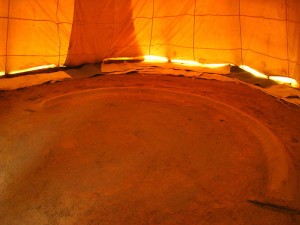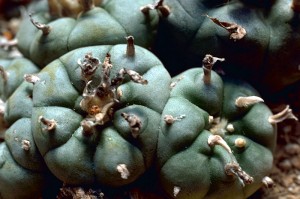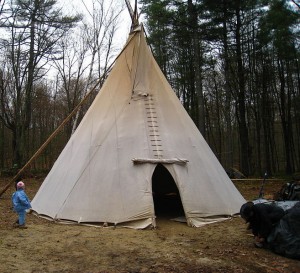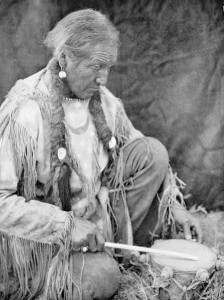Native American Church

Peyote and the Native American Church
An in depth look into the roots of the Native American Church and their use of Peyote.
 Native American Church Insignia
Native American Church Insignia
The Native American Church (NAC) is an indigenous religion that uses the entheogen peyote (Lophophora williamsii) sacramentally to induce religious, shamanic, or spiritual experiences. Peyotism, or the Peyote Religion, originated in the U.S. state of Oklahoma and is the most widespread indigenous religion among Native Americans in the United States.
History of the Peyote Religion
Peyote was used in the territory of modern Mexico in pre-Columbian times to commune with the spirit world and also as a medicine. From the mid-15th century, the use of peyote spread to the Great Plains area of the United States primarily through the efforts of the Apache, Navajo, Plains Tribes, and various tribes in the western United States. Peyotism is now practiced in more than 50 Native American tribes and has around 250,000 adherents.
Peyotist’s beliefs vary considerably from tribe to tribe and NAC chapter to chapter. Half moon fireplaces usually have the biggest variety of varied religious beliefs, while Cross fire fireplaces primarily have Christian members in their chapters. This does not take in to account tribal entities supporting one another despite not being affiliated with Half moon or Cross fire fireplaces and vice versa.
Native American Church ceremonies have a form and structure that is adhered to as closely as possible. Like other traditional indigenous ways of life, fireplaces are passed down generation to generation from tribal entity to tribal entity. They are adhered to, with little variation, because they want to retain the structure to pass down to the next generation of family and relatives.
Conflict arises within the peyote communities across the county because non-Native American and non-tribal affiliated chapters decide to diverge from traditional structure and change aspects of the ceremony at will. While some tribes find it acceptable to do so, a majority do not and feel it is disrespectful to peyote and to this way of life. Also, racial politics i.e. whether Non Natives can participate in peyote ceremonies, is a highly contentious issue that has been at the forefront of the peyote community for a long time. Looking at two current, major NAC chapters in this country showcases this interesting dichotomy: the Native American Church of the United States, the original umbrella incorporated church birthed in 1918 from which many other chapters are tied to, allows Non Natives to participate, in regulation with State law. On the other hand, the Native American Church of North America, incorporated much later in the 1950s, only allows Native Americans with a 1/4 Indian blood quantum and CIB certificate to participate (Omer Stewart – Peyote Religion).
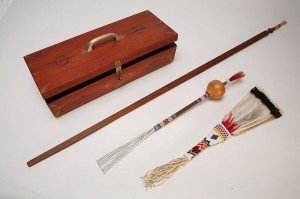 A peyote set such as this is used by the medicine man during the peyote ritual.
A peyote set such as this is used by the medicine man during the peyote ritual.
For some chapters of the Native American Church, the peyote ritual begins at sundown on a Saturday and continues through the night. The ritual includes prayer, the eating of peyote, peyote songs, water rituals, and contemplation. It ends with breakfast Sunday morning. The peyote ritual is believed to allow communion with Holy deity or spirits, and to give power, authority, guidance, and healing. The healing may be emotional or physical, or both.
Those church members who feel that they need structure believe that the communal ingestion of peyote and the ceremony of the church meeting help participants get into a proper relationship with each other and with the Holy deity or spirits. In turn, they believe, this leads to an ability to live a good day-to-day life. A good life is considered to be one that is kind and responsible, and embodies harmony.
United States Law – Federal Law
As a result of the U.S. Supreme Court decision in Employment Division, Department of Human Resources of Oregon v. Smith, 494 U.S. 872 (1990), which, among other things, put the legal use of peyote by American Indians into uncertainty and potential legal jeopardy, Congress passed an amendment to the American Indian Religious Freedom Act of 1978 (42 U.S.C. § 1996), i.e., the American Indian Religious Freedom Act Amendments of 1994 (42 U.S.C. § 1996a), pertinent excerpts of which are given below:
- Use, possession, or transportation of peyote
Notwithstanding any other provision of law, the use, possession, or transportation of peyote by an Indian for bona fide traditional ceremonial purposes in connection with the practice of a traditional Indian religion is lawful, and shall not be prohibited by the United States or any State. No Indian shall be penalized or discriminated against on the basis of such use, possession or transportation, including, but not limited to, denial of otherwise applicable benefits under public assistance programs.
—42 U.S.C. 1996A(b)(1).
- Definitions
For purposes of this section— (1) the term “Indian” means a member of an Indian tribe; (2) the term “Indian tribe” means any tribe, band, nation, pueblo, or other organized group or community of Indians, including any Alaska Native village (as defined in, or established pursuant to, the Alaska Native Claims Settlement Act (43 U.S.C. § 1601 et seq.)), which is recognized as eligible for the special programs and services provided by the United States to Indians because of their status as Indians; (3) the term “Indian religion” means any religion— (A) which is practiced by Indians, and
(B) the origin and interpretation of which is from within a traditional Indian culture or community; and (4) the term “State” means any State of the United States, and any political subdivision thereof.
—42 U.S.C. 1996A(c)
- Protection of rights of Indians and Indian tribes
Nothing in this section shall be construed as abrogating, diminishing, or otherwise affecting— (1) the inherent rights of any Indian tribe; (2) the rights, express or implicit, of any Indian tribe which exist under treaties, Executive orders, and laws of the United States; (3) the inherent right of Indians to practice their religions; and
(4) the right of Indians to practice their religions under any Federal or State law.
—42 U.S.C. 1996A(d)
State Law
Currently, laws regulating peyote use by Native American Church members vary by state.
Native American Church Movement
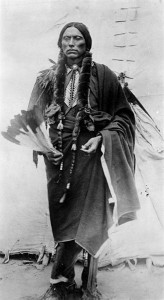 Quanah Parker clasping a peyote feather fan
Quanah Parker clasping a peyote feather fan
Quanah Parker, along with other prominent roadmen, was influential in the adoption of the Native American Church by tribal entities in the United States. Even though historically ceremonies are much older, the NAC movement started generally in the 1880s, and was formally incorporated in 1918 in Oklahoma. Parker became aware of the healing capabilites of peyote after being gored by a bull in South Laredo, Texas and surviving the attack with the help of peyote. Parker was given strong peyote tea by a curandera (the tribal affiliation, whether of Mexican Indian or Native American descent, is currently unknown) who healed him and showed him how to properly pray with peyote. Therefore, the genesis of modern NAC ceremonies have deep roots in both Mexican and Native American culture and ritual, due to the natural locality of peyote and the dissemination by Parker to the Comanche and other plains tribes located in Indian Territory.
Though there are many variations, the main two ceremonial styles of the NAC are the “half moon” fireplace and the “cross fire” fireplace. Parker learned the “half-moon” style of the peyote ceremony from the Lipan Apache leader Chiwat. The Lipan Apache learned the ceremony from the Carrizo/Comecrudo tribe of Southern Texas (Peyote Religion by Omer Stewart). The “half moon” fireplace hallmarks include the use of tobacco throughout, and very little to no use of the bible in the ceremony. This does vary tribe to tribe. The “cross fire” ceremony (originally called the “Big Moon” ceremony) became prevalent in Oklahoma (initially among the Kiowa) due to the influence of John Wilson, a Caddo man who traveled extensively around the same time as Parker during the early days of the Native American Church movement. The “cross fire” ceremony has elements that separate it strongly from the Half Moon. Usually, there is no tobacco used in the meeting and the use of the bible is used extensively. Therefore, it is a merger of both indigenous ritual and Christian doctrine and belief.
Peyoteros of South Texas
The peyote religion evolved an elaborate trade network which has persisted since pre-Columbian times, in South Texas, with designated harvesters of the peyote in Rio Grande City, Texas, and Mirando City, Texas. The Peyoteros are a group of closely knit families of Mexican ancestry who have harvested peyote for Native Americans since the early 18th century. The modern peyoteros still harvest peyote in the same manner as their ancestors, with a machete and a very small work crew of young and sometimes old men. Peyote is harvested and dried after the crowns of the plants are removed at ground level; cut at an angle, to allow water to run off. The peyoteros never dig up peyote, but rather cut the tops of the cactus crowns at ground level with a machete. Peyote plants create large taproots with an extensive root system, and the plants slowly regenerate new heads after harvest, often producing a much larger plant after several years of regrowth. Currently, peyote is being over-harvested, seriously endangering the existence of the local populations of peyote. There are three licensed peyoteros left in Texas due to over-harvesting, illegal poaching, and strict licensing and tax regulations by the Texas Department of Public Safety and the U.S. Federal government. Two peyoteros in South Texas are Mauro Morales of Rio Grande City, Texas, and Salvador Johnson of Mirando City, Texas.
Native American are permitted to purchase peyote to supply the Native American Church both in person and via US Mails “Restricted Delivery” procedures. Special ceremonies are performed with the harvested and dried peyote medicine in order to bless it for use as a sacrament for Native American Church rituals and ceremonies.
All three of the peyoteros are licensed by the United States Drug Enforcement Administration and operate under DEA 225 permits. Peyoteros are also required to be registered with the State of Texas Department of Public Safety, for a fee over $1,200 per year. Legitimate Native American Church branches are required to register with the Texas Department of Public Safety in order to purchase, harvest, transport, or cultivate peyote. Non-Native American churches not affiliated with federally-recognized tribal entities are not eligible for registration with the Texas Department of Public Safety at this time.

